rear seat Peugeot 308 CC 2011 Owner's Guide
[x] Cancel search | Manufacturer: PEUGEOT, Model Year: 2011, Model line: 308 CC, Model: Peugeot 308 CC 2011Pages: 292, PDF Size: 40.04 MB
Page 113 of 292
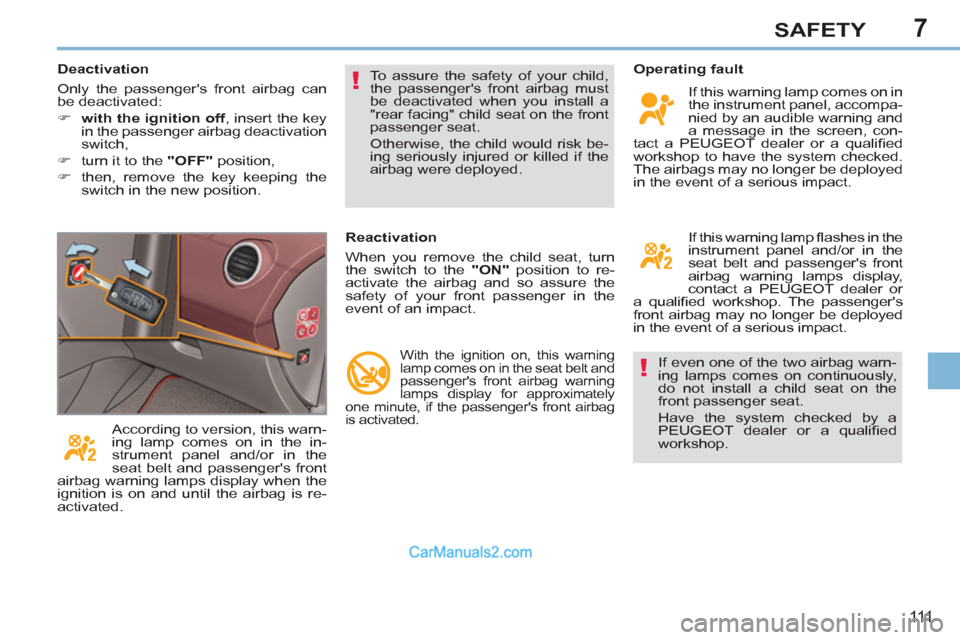
7
!
!
111
SAFETY
If even one of the two airbag warn-
ing lamps comes on continuously,
do not install a child seat on the
front passenger seat.
Have the system checked by a
PEUGEOT dealer or a qualifi ed
workshop.
Operating fault
If this warning lamp comes on in
the instrument panel, accompa-
nied by an audible warning and
a message in the screen, con-
tact a PEUGEOT dealer or a qualifi ed
workshop to have the system checked.
The airbags may no longer be deployed
in the event of a serious impact.
Reactivation
When you remove the child seat, turn
the switch to the "ON"
position to re-
activate the airbag and so assure the
safety of your front passenger in the
event of an impact. With the ignition on, this warning
lamp comes on in the seat belt and
passenger's front airbag warning
lamps display for approximately
one minute, if the passenger's front airbag
is activated.
To assure the safety of your child,
the passenger's front airbag must
be deactivated when you install a
"rear facing" child seat on the front
passenger seat.
Otherwise, the child would risk be-
ing seriously injured or killed if the
airbag were deployed.
According to version, this warn-
ing lamp comes on in the in-
strument panel and/or in the
seat belt and passenger's front
airbag warning lamps display when the
ignition is on and until the airbag is re-
activated. If this warning lamp fl ashes in the
instrument panel and/or in the
seat belt and passenger's front
airbag warning lamps display,
contact a PEUGEOT dealer or
a qualifi ed workshop. The passenger's
front airbag may no longer be deployed
in the event of a serious impact.
Deactivation
Only the passenger's front airbag can
be deactivated:
�)
with the ignition off
, insert the key
in the passenger airbag deactivation
switch,
�)
turn it to the "OFF"
position,
�)
then, remove the key keeping the
switch in the new position.
Page 114 of 292
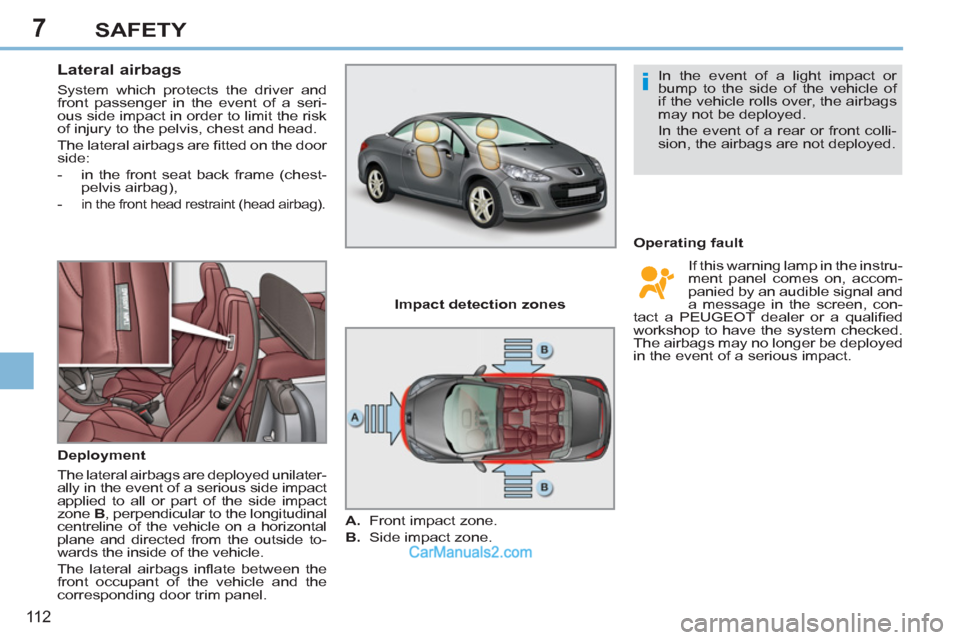
7
i
11 2
SAFETY
Lateral airbags
System which protects the driver and
front passenger in the event of a seri-
ous side impact in order to limit the risk
of injury to the pelvis, chest and head.
The lateral airbags are fi tted on the door
side:
- in the front seat back frame (chest-
pelvis airbag),
-
in the front head restraint (head airbag).
Deployment
The lateral airbags are deployed unilater-
ally in the event of a serious side impact
applied to all or part of the side impact
zone B
, perpendicular to the longitudinal
centreline of the vehicle on a horizontal
plane and directed from the outside to-
wards the inside of the vehicle.
The lateral airbags infl ate between the
front occupant of the vehicle and the
corresponding door trim panel.
Operating fault
Impact detection zones
A.
Front impact zone.
B.
Side impact zone. If this warning lamp in the instru-
ment panel comes on, accom-
panied by an audible signal and
a message in the screen, con-
tact a PEUGEOT dealer or a qualifi ed
workshop to have the system checked.
The airbags may no longer be deployed
in the event of a serious impact.
In the event of a light impact or
bump to the side of the vehicle of
if the vehicle rolls over, the airbags
may not be deployed.
In the event of a rear or front colli-
sion, the airbags are not deployed.
Page 116 of 292
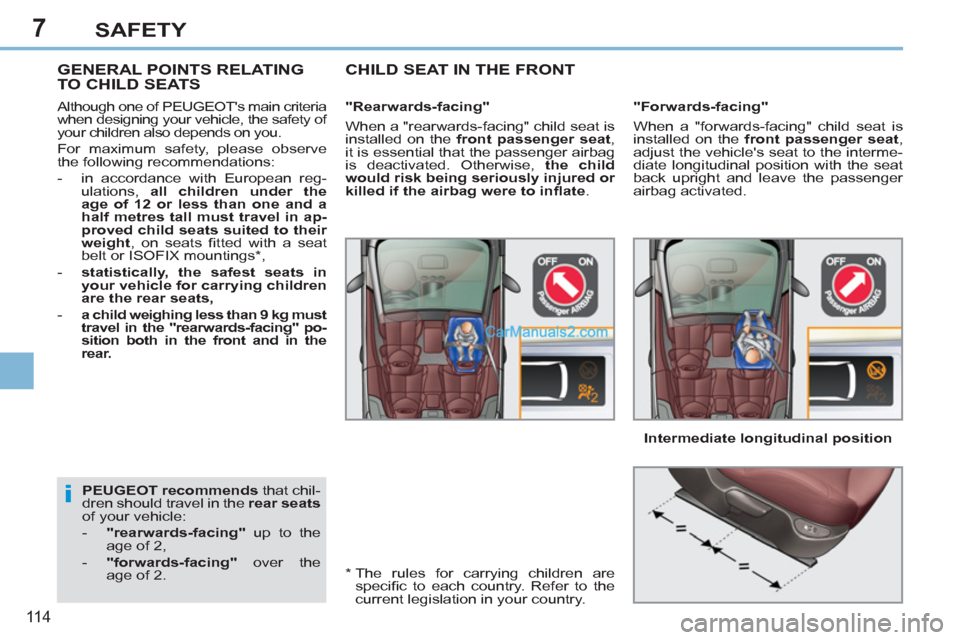
7
i
11 4
SAFETY
PEUGEOT recommends
that chil-
dren should travel in the rear seats
of your vehicle:
- "rearwards-facing"
up to the
age of 2,
- "forwards-facing"
over the
age of 2.
GENERAL POINTS RELATING
TO CHILD SEATS CHILD SEAT IN THE FRONT
"Forwards-facing"
When a "forwards-facing" child seat is
installed on the front passenger seat
,
adjust the vehicle's seat to the interme-
diate longitudinal position with the seat
back upright and leave the passenger
airbag activated.
"Rearwards-facing"
When a "rearwards-facing" child seat is
installed on the front passenger seat
,
it is essential that the passenger airbag
is deactivated. Otherwise, the child
would risk being seriously injured or
killed if the airbag were to infl ate
.
*
The rules for carrying children are
specifi c to each country. Refer to the
current legislation in your country. Although one of PEUGEOT's main criteria
when designing your vehicle, the safety of
your children also depends on you.
For maximum safety, please observe
the following recommendations:
- in accordance with European reg-
ulations, all children under the
age of 12 or less than one and a
half metres tall must travel in ap-
proved child seats suited to their
weight
, on seats fi tted with a seat
belt or ISOFIX mountings * ,
- statistically, the safest seats in
your vehicle for carrying children
are the rear seats,
- a child weighing less than 9 kg must
travel in the "rearwards-facing" po-
sition both in the front and in the
rear.
Intermediate longitudinal position
Page 117 of 292
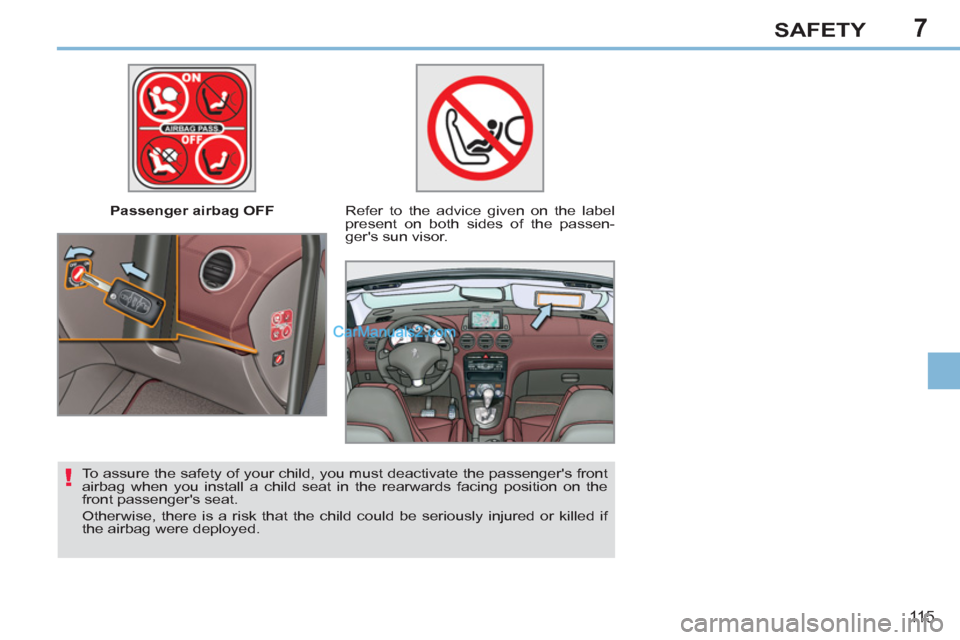
7
!
11 5
SAFETY
Passenger airbag OFF
Refer to the advice given on the label
present on both sides of the passen-
ger's sun visor.
To assure the safety of your child, you must deactivate the passenger's front
airbag when you install a child seat in the rearwards facing position on the
front passenger's seat.
Otherwise, there is a risk that the child could be seriously injured or killed if
the airbag were deployed.
Page 118 of 292
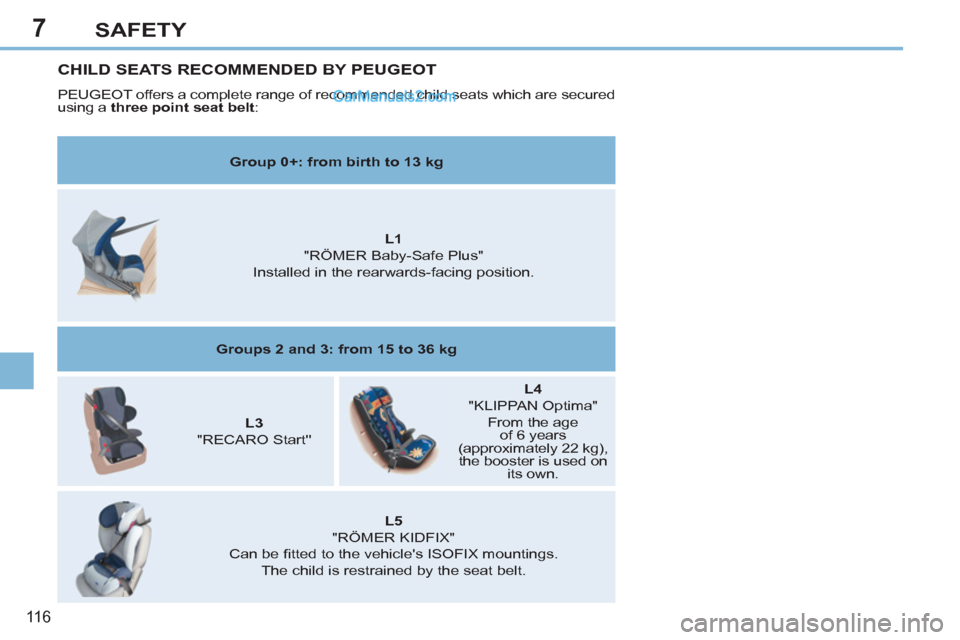
7
11 6
SAFETY
CHILD SEATS RECOMMENDED BY PEUGEOT
PEUGEOT offers a complete range of recommended child seats which are secured
using a three point seat belt
:
Group 0+: from birth to 13 kg
L1
"RÖMER Baby-Safe Plus"
Installed in the rearwards-facing position.
Groups 2 and 3: from 15 to 36 kg
L3
"RECARO Start''
L4
"KLIPPAN Optima"
From the age
of 6 years
(approximately 22 kg),
the booster is used on
its own.
L5
"RÖMER KIDFIX"
Can be fi tted to the vehicle's ISOFIX mountings.
The child is restrained by the seat belt.
Page 119 of 292
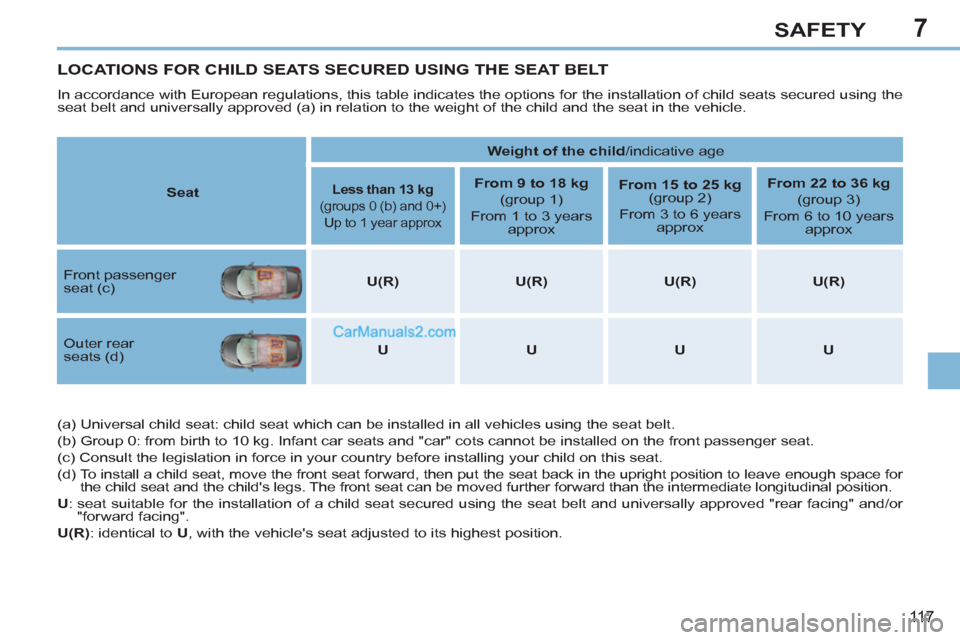
7
11 7
SAFETY
LOCATIONS FOR CHILD SEATS SECURED USING THE SEAT BELT
In accordance with European regulations, this table indicates the options for the installation of child seats secured using the
seat belt and universally approved (a) in relation to the weight of the child and the seat in the vehicle.
(a) Universal child seat: child seat which can be installed in all vehicles using the seat belt.
(b) Group 0: from birth to 10 kg. Infant car seats and "car" cots cannot be installed on the front passenger seat.
(c) Consult the legislation in force in your country before installing your child on this seat.
(d) To install a child seat, move the front seat forward, then put the seat back in the upright position to leave enough space for
the child seat and the child's legs. The front seat can be moved further forward than the intermediate longitudinal position.
U
: seat suitable for the installation of a child seat secured using the seat belt and universally approved "rear facing" and/or
"forward facing".
U(R)
: identical to U
, with the vehicle's seat adjusted to its highest position.
Seat
Weight of the child
/indicative age
Less than 13 kg
(groups 0 (b) and 0+)
Up to 1 year approx
From 9 to 18 kg
(group 1)
From 1 to 3 years
approx
From 15 to 25 kg
(group 2)
From 3 to 6 years
approx
From 22 to 36 kg
(group 3)
From 6 to 10 years
approx
Front passenger
seat (c)
U(R)
U(R)
U(R)
U(R)
Outer rear
seats (d)
U
U
U
U
Page 120 of 292
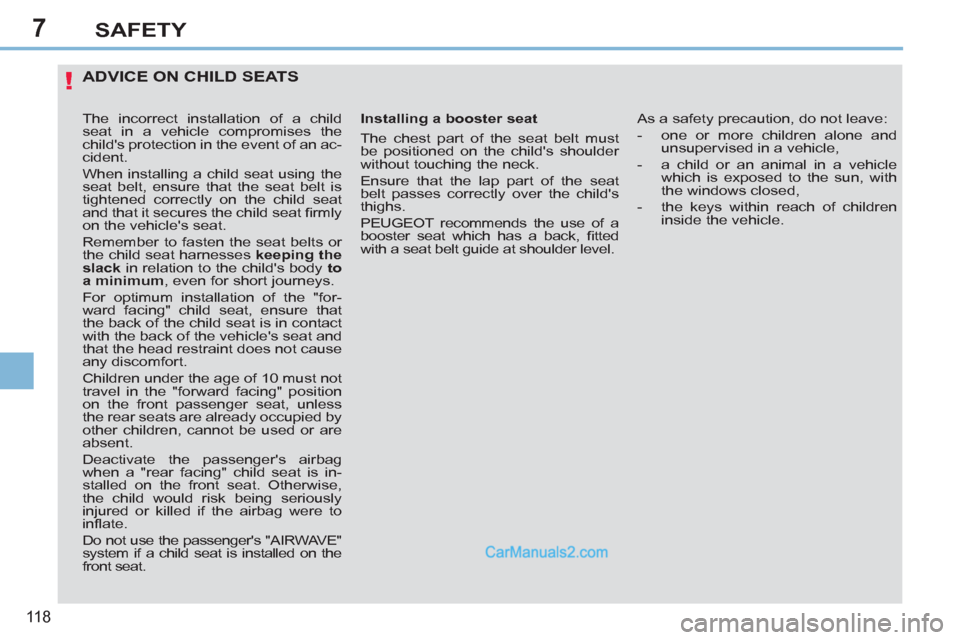
7
!
11 8
SAFETY
ADVICE ON CHILD SEATS
Installing a booster seat
The chest part of the seat belt must
be positioned on the child's shoulder
without touching the neck.
Ensure that the lap part of the seat
belt passes correctly over the child's
thighs.
PEUGEOT recommends the use of a
booster seat which has a back, fi tted
with a seat belt guide at shoulder level. As a safety precaution, do not leave:
- one or more children alone and
unsupervised in a vehicle,
- a child or an animal in a vehicle
which is exposed to the sun, with
the windows closed,
- the keys within reach of children
inside the vehicle.
The incorrect installation of a child
seat in a vehicle compromises the
child's protection in the event of an ac-
cident.
When installing a child seat using the
seat belt, ensure that the seat belt is
tightened correctly on the child seat
and that it secures the child seat fi rmly
on the vehicle's seat.
Remember to fasten the seat belts or
the child seat harnesses keeping
the
slack
in relation to the child's body to
a minimum
, even for short journeys.
For optimum installation of the "for-
ward facing" child seat, ensure that
the back of the child seat is in contact
with the back of the vehicle's seat and
that the head restraint does not cause
any discomfort.
Children under the age of 10 must not
travel in the "forward facing" position
on the front passenger seat, unless
the rear seats are already occupied by
other children, cannot be used or are
absent.
Deactivate the passenger's airbag
when a "rear facing" child seat is in-
stalled on the front seat. Otherwise,
the child would risk being seriously
injured or killed if the airbag were to
infl ate.
Do not use the passenger's "AIRWAVE"
system if a child seat is installed on the
front seat.
Page 123 of 292
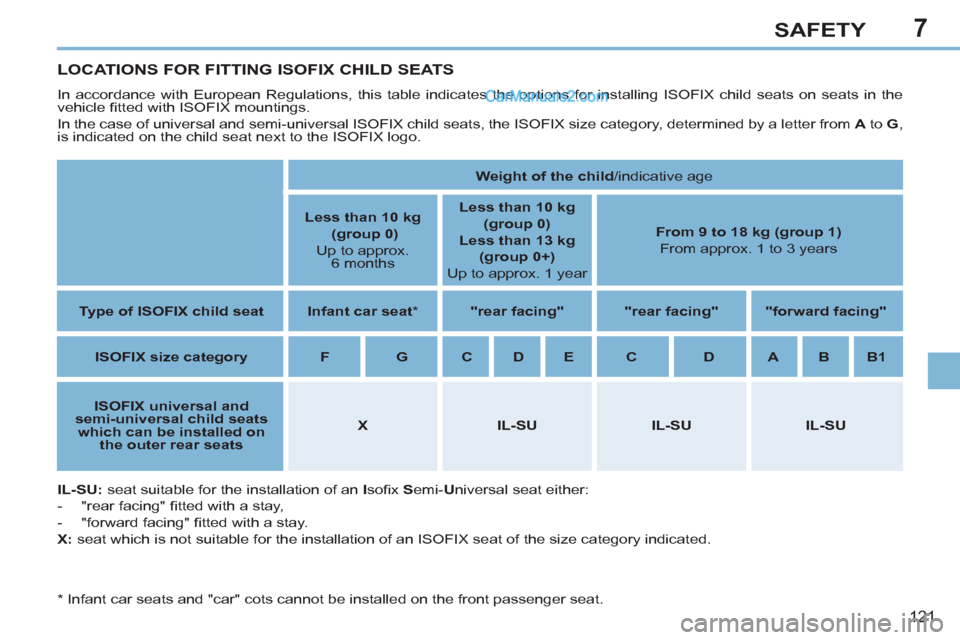
7
121
SAFETY
LOCATIONS FOR FITTING ISOFIX CHILD SEATS
In accordance with European Regulations, this table indicates the options for installing ISOFIX child seats on seats in the
vehicle fi tted with ISOFIX mountings.
In the case of universal and semi-universal ISOFIX child seats, the ISOFIX size category, determined by a letter from A
to G
,
is indicated on the child seat next to the ISOFIX logo.
IL-SU:
seat suitable for the installation of an I
sofi x S
emi- U
niversal seat either:
- "rear facing" fi tted with a stay,
- "forward facing" fi tted with a stay.
X:
seat which is not suitable for the installation of an ISOFIX seat of the size category indicated.
Weight of the child
/indicative age
Less than 10 kg
(group 0)
Up to approx.
6 months
Less than 10 kg
(group 0)
Less than 13 kg
(group 0+)
Up to approx. 1 year
From 9 to 18 kg (group 1)
From approx. 1 to 3 years
Type of ISOFIX child seat
Infant car seat
*
"rear facing"
"rear facing"
"forward facing"
ISOFIX size category
F
G
C
D
E
C
D
A
B
B1
ISOFIX
universal and
semi-universal
child seats
which can be installed on
the
outer rear seats
X
IL-SU
IL-SU
IL-SU
* Infant car seats and "car" cots cannot be installed on the front passenger seat.
Page 164 of 292
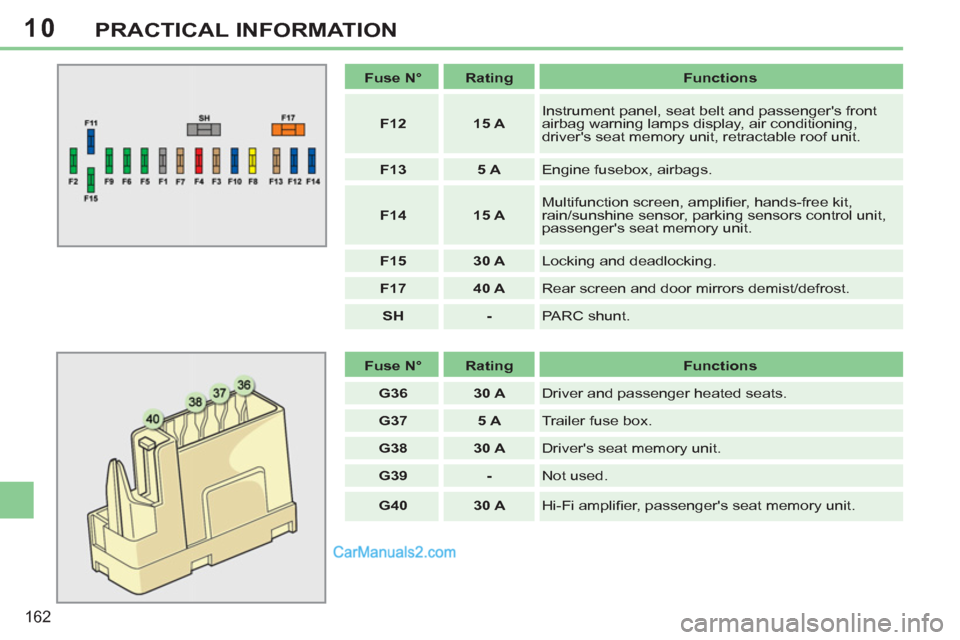
10
162
PRACTICAL INFORMATION
Fuse N°
Rating
Functions
F12
15 A
Instrument panel, seat belt and passenger's front
airbag warning lamps display, air conditioning,
driver's seat memory unit, retractable roof unit.
F13
5 A
Engine fusebox, airbags.
F14
15 A
Multifunction screen, amplifi er, hands-free kit,
rain/sunshine sensor, parking sensors control unit,
passenger's seat memory unit.
F15
30 A
Locking and deadlocking.
F17
40 A
Rear screen and door mirrors demist/defrost.
SH
-
PARC shunt.
Fuse N°
Rating
Functions
G36
30 A
Driver and passenger heated seats.
G37
5 A
Trailer fuse box.
G38
30 A
Driver's seat memory unit.
G39
-
Not used.
G40
30 A
Hi-Fi amplifi er, passenger's seat memory unit.
Page 282 of 292
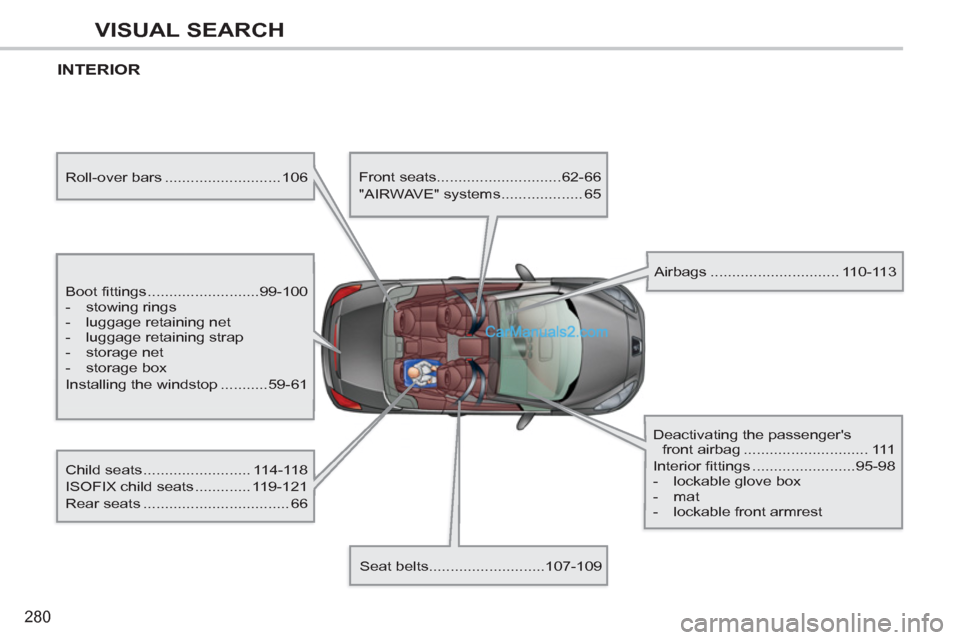
280
VISUAL SEARCH
INTERIOR
Boot fittings ..........................99-100
- stowing rings
- luggage retaining net
- luggage retaining strap
- storage net
- storage box
Installing the windstop ...........59-61
Child seats ......................... 114-118
ISOFIX child seats ............. 119-121
Rear seats .................................. 66
Front seats.............................62-66
"AIRWAVE" systems ................... 65
Seat belts...........................107-109
Airbags .............................. 110-113
Deactivating the passenger's
front airbag ............................. 111
Interior fittings ........................95-98
- lockable glove box
- mat
- lockable front armrest
Roll-over bars ........................... 106